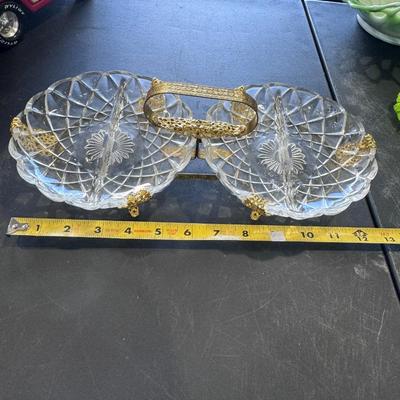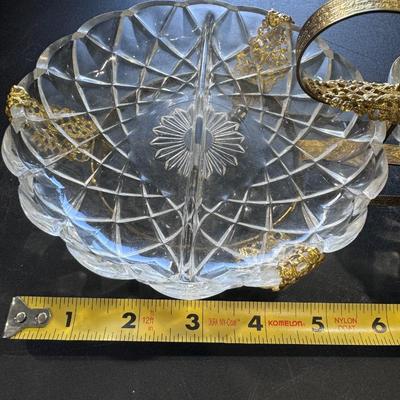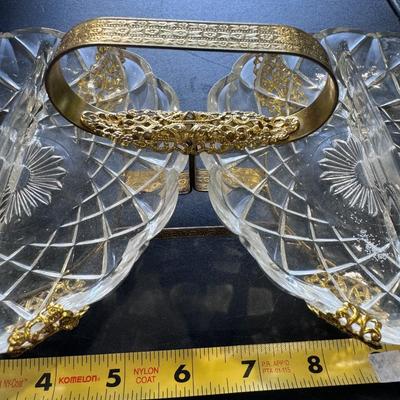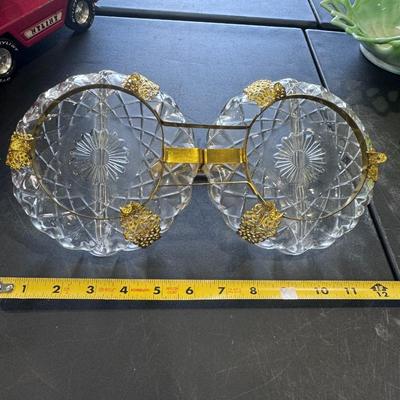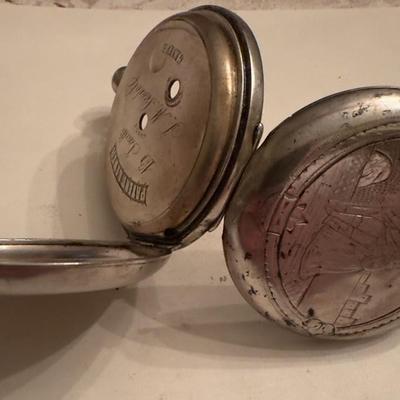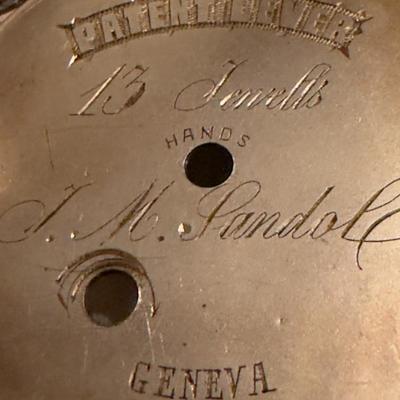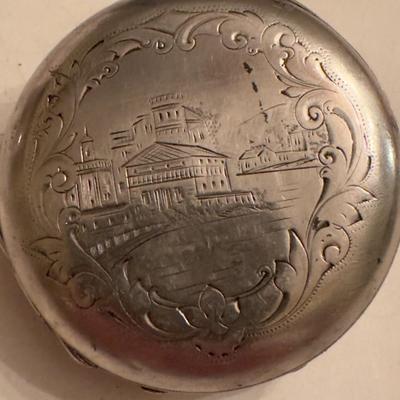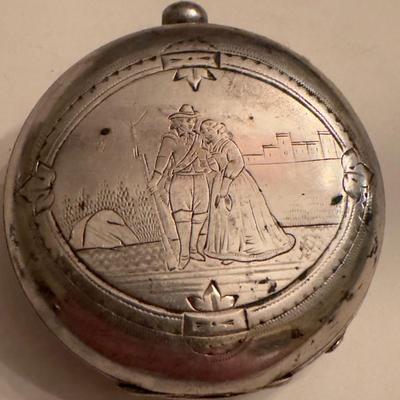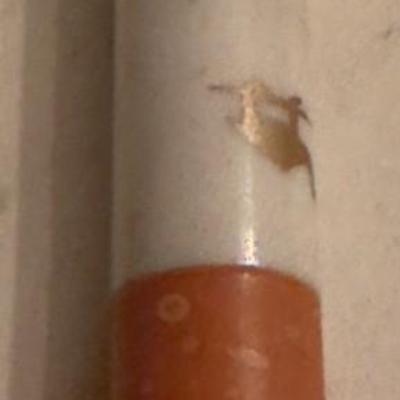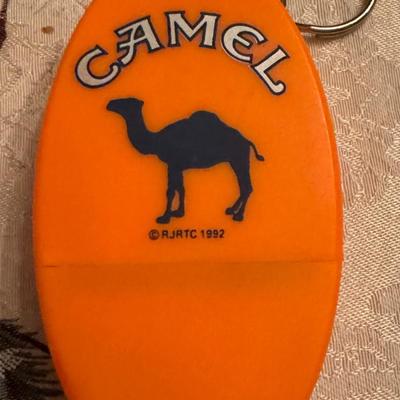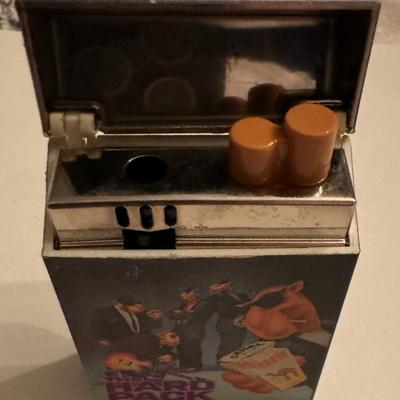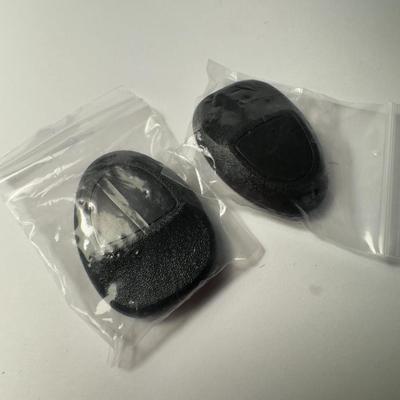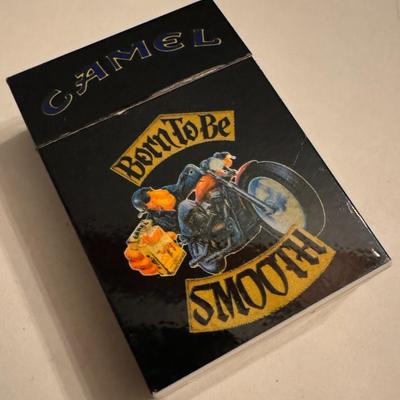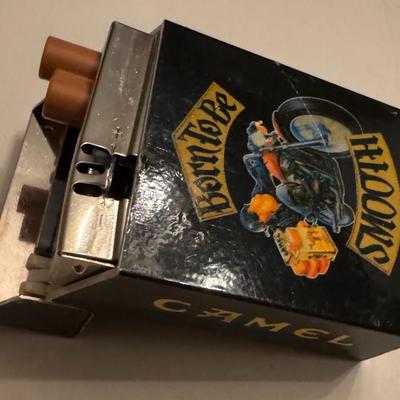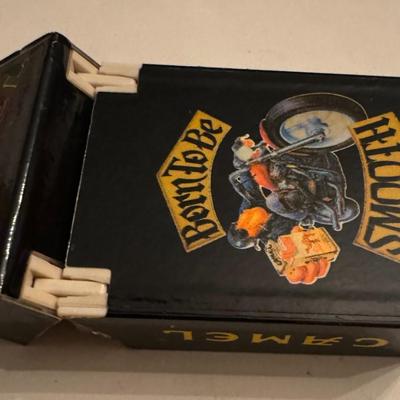-
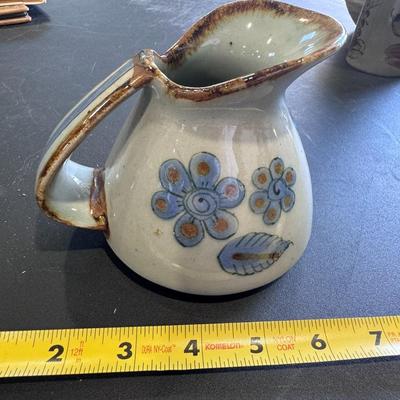
Ken Edwards El Palomar Pottery Pitcher from Tonala, Mexico. This style of pottery is known for its handcrafted nature and distinctive designs, often featuring birds and florals. Here's more information about the item: Origin: Made in Tonalá, Mexico, by the renowned potter Ken Edwards, or his studio, under the El Palomar line. Characteristics: This piece features hand-painted blue floral designs on a light-colored stoneware background, with a contrasting brown rim and handle. Material: It is made of lead-free stoneware, a hallmark of Ken Edwards's work. Uniqueness: Each piece of Ken Edwards pottery is handcrafted and unique, with slight variations in design and size. 1101 / 1369 -
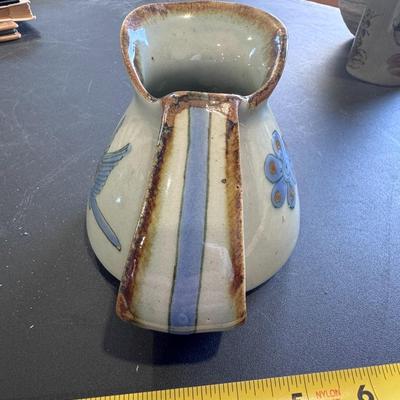
Ken Edwards El Palomar Pottery Pitcher from Tonala, Mexico. This style of pottery is known for its handcrafted nature and distinctive designs, often featuring birds and florals. Here's more information about the item: Origin: Made in Tonalá, Mexico, by the renowned potter Ken Edwards, or his studio, under the El Palomar line. Characteristics: This piece features hand-painted blue floral designs on a light-colored stoneware background, with a contrasting brown rim and handle. Material: It is made of lead-free stoneware, a hallmark of Ken Edwards's work. Uniqueness: Each piece of Ken Edwards pottery is handcrafted and unique, with slight variations in design and size. 1102 / 1369 -
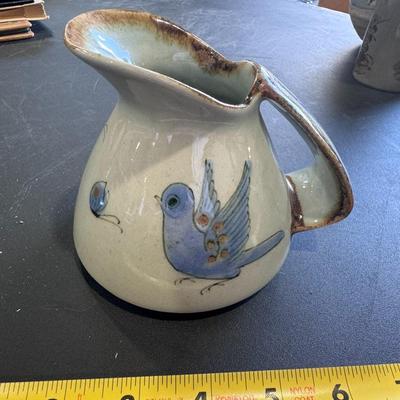
Ken Edwards El Palomar Pottery Pitcher from Tonala, Mexico. This style of pottery is known for its handcrafted nature and distinctive designs, often featuring birds and florals. Here's more information about the item: Origin: Made in Tonalá, Mexico, by the renowned potter Ken Edwards, or his studio, under the El Palomar line. Characteristics: This piece features hand-painted blue floral designs on a light-colored stoneware background, with a contrasting brown rim and handle. Material: It is made of lead-free stoneware, a hallmark of Ken Edwards's work. Uniqueness: Each piece of Ken Edwards pottery is handcrafted and unique, with slight variations in design and size. 1103 / 1369 -
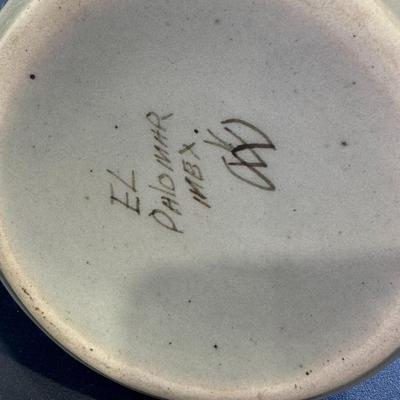
Ken Edwards El Palomar Pottery Pitcher from Tonala, Mexico. This style of pottery is known for its handcrafted nature and distinctive designs, often featuring birds and florals. Here's more information about the item: Origin: Made in Tonalá, Mexico, by the renowned potter Ken Edwards, or his studio, under the El Palomar line. Characteristics: This piece features hand-painted blue floral designs on a light-colored stoneware background, with a contrasting brown rim and handle. Material: It is made of lead-free stoneware, a hallmark of Ken Edwards's work. Uniqueness: Each piece of Ken Edwards pottery is handcrafted and unique, with slight variations in design and size. 1104 / 1369 -
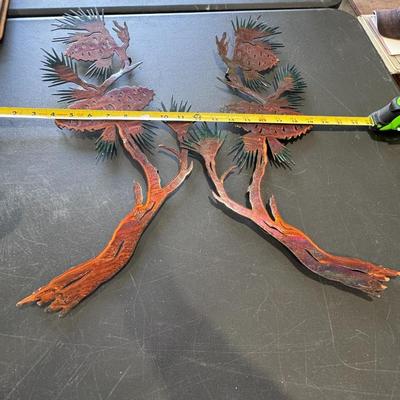
two large metal wall decor pieces 1105 / 1369 -
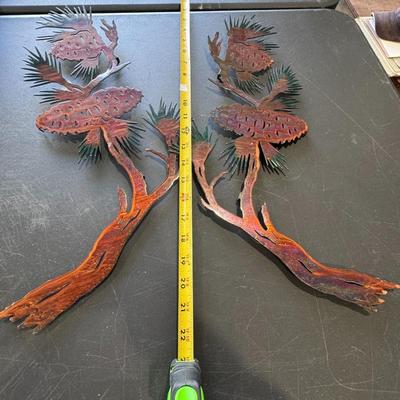
two large metal wall decor pieces 1106 / 1369 -
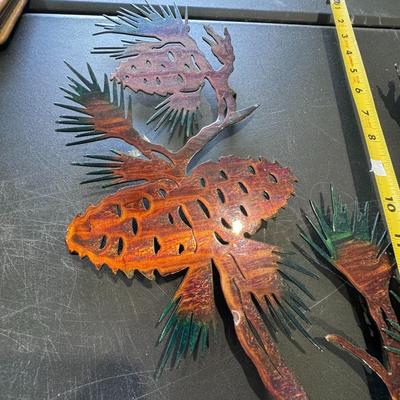
two large metal wall decor pieces 1107 / 1369 -
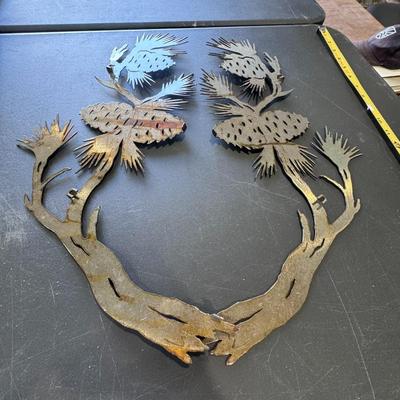
two large metal wall decor pieces 1108 / 1369 -
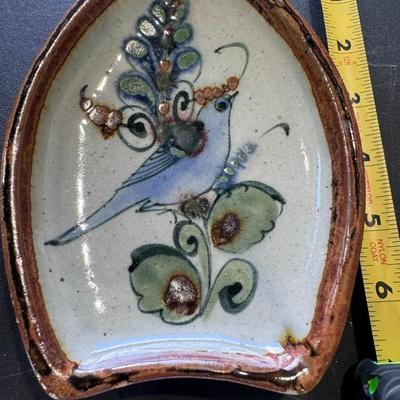
Origin and Craftsmanship: It is a product of Tonala, Jalisco, a region in Mexico renowned for its pottery, particularly the burnished or petatillo style. Ken Edwards, a well-known name in Mexican pottery, established a studio in Tonala, training local artisans. Distinctive Features: The dish showcases the characteristic hand-painted style of Ken Edwards pottery, known for its lead-free, high-temperature stoneware. Pieces from his studio are often signed with his initials "KE" and sometimes by the individual artist's signature, often an animal, fish, or insect. Design and Use: This specific piece features a vibrant blue bird as a central motif, surrounded by stylized floral elements, reflecting the natural inspirations common in Tonala pottery. It's designed as a trinket dish or small tray, suitable for decorative purposes or holding small items. 1109 / 1369 -
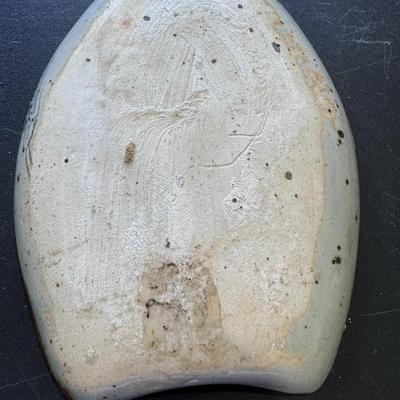
Origin and Craftsmanship: It is a product of Tonala, Jalisco, a region in Mexico renowned for its pottery, particularly the burnished or petatillo style. Ken Edwards, a well-known name in Mexican pottery, established a studio in Tonala, training local artisans. Distinctive Features: The dish showcases the characteristic hand-painted style of Ken Edwards pottery, known for its lead-free, high-temperature stoneware. Pieces from his studio are often signed with his initials "KE" and sometimes by the individual artist's signature, often an animal, fish, or insect. Design and Use: This specific piece features a vibrant blue bird as a central motif, surrounded by stylized floral elements, reflecting the natural inspirations common in Tonala pottery. It's designed as a trinket dish or small tray, suitable for decorative purposes or holding small items. 1110 / 1369 -
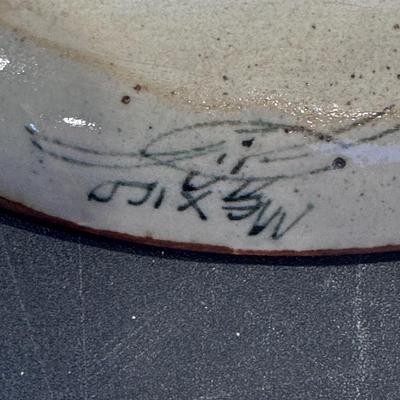
Origin and Craftsmanship: It is a product of Tonala, Jalisco, a region in Mexico renowned for its pottery, particularly the burnished or petatillo style. Ken Edwards, a well-known name in Mexican pottery, established a studio in Tonala, training local artisans. Distinctive Features: The dish showcases the characteristic hand-painted style of Ken Edwards pottery, known for its lead-free, high-temperature stoneware. Pieces from his studio are often signed with his initials "KE" and sometimes by the individual artist's signature, often an animal, fish, or insect. Design and Use: This specific piece features a vibrant blue bird as a central motif, surrounded by stylized floral elements, reflecting the natural inspirations common in Tonala pottery. It's designed as a trinket dish or small tray, suitable for decorative purposes or holding small items. 1111 / 1369 -
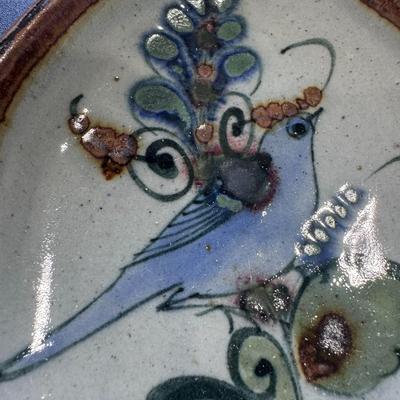
Origin and Craftsmanship: It is a product of Tonala, Jalisco, a region in Mexico renowned for its pottery, particularly the burnished or petatillo style. Ken Edwards, a well-known name in Mexican pottery, established a studio in Tonala, training local artisans. Distinctive Features: The dish showcases the characteristic hand-painted style of Ken Edwards pottery, known for its lead-free, high-temperature stoneware. Pieces from his studio are often signed with his initials "KE" and sometimes by the individual artist's signature, often an animal, fish, or insect. Design and Use: This specific piece features a vibrant blue bird as a central motif, surrounded by stylized floral elements, reflecting the natural inspirations common in Tonala pottery. It's designed as a trinket dish or small tray, suitable for decorative purposes or holding small items. 1112 / 1369 -
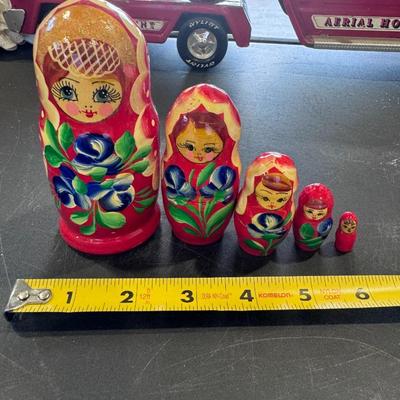
5 section wooden nesting doll / made in Russia 1113 / 1369 -
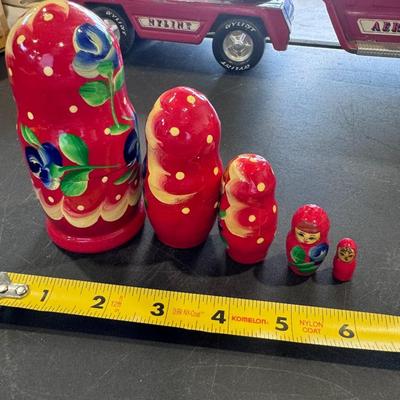
5 section wooden nesting doll / made in Russia 1114 / 1369 -
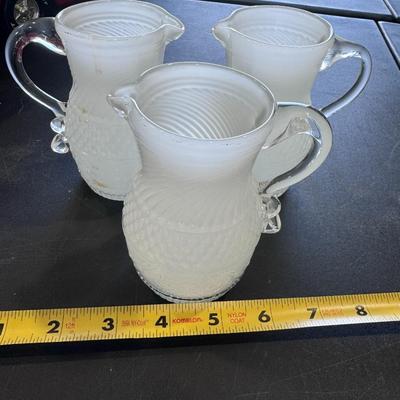
Maker and Period: Challinor, Taylor and Company operated from 1884 to 1891, when it became Factory C of US Glass Co.. This creamer likely dates to the late 1880s, reflecting the popular milk glass trend of the era. Material: It is made of milk glass, an opaque white or off-white glass known for its distinctive appearance, often resembling porcelain. Pattern: The "Cobb" pattern features a distinctive design, including a clear handle and intricate textures on the body, combining a swirled upper section and a diamond or waffle-like lower section. 1119 / 1369 -
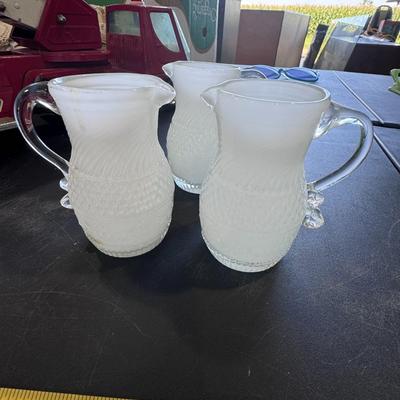
Maker and Period: Challinor, Taylor and Company operated from 1884 to 1891, when it became Factory C of US Glass Co.. This creamer likely dates to the late 1880s, reflecting the popular milk glass trend of the era. Material: It is made of milk glass, an opaque white or off-white glass known for its distinctive appearance, often resembling porcelain. Pattern: The "Cobb" pattern features a distinctive design, including a clear handle and intricate textures on the body, combining a swirled upper section and a diamond or waffle-like lower section. 1120 / 1369 -
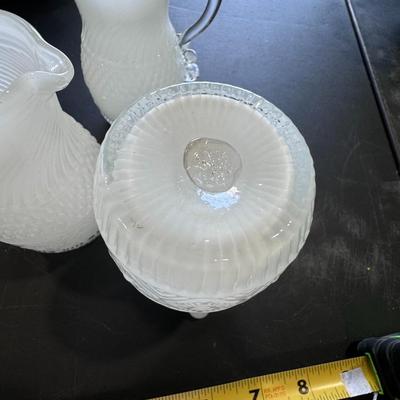
Maker and Period: Challinor, Taylor and Company operated from 1884 to 1891, when it became Factory C of US Glass Co.. This creamer likely dates to the late 1880s, reflecting the popular milk glass trend of the era. Material: It is made of milk glass, an opaque white or off-white glass known for its distinctive appearance, often resembling porcelain. Pattern: The "Cobb" pattern features a distinctive design, including a clear handle and intricate textures on the body, combining a swirled upper section and a diamond or waffle-like lower section. 1121 / 1369 -

Maker and Period: Challinor, Taylor and Company operated from 1884 to 1891, when it became Factory C of US Glass Co.. This creamer likely dates to the late 1880s, reflecting the popular milk glass trend of the era. Material: It is made of milk glass, an opaque white or off-white glass known for its distinctive appearance, often resembling porcelain. Pattern: The "Cobb" pattern features a distinctive design, including a clear handle and intricate textures on the body, combining a swirled upper section and a diamond or waffle-like lower section. 1122 / 1369 -
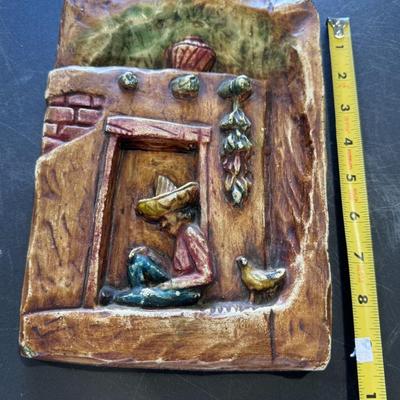
decorative ceramic wall plaque, commonly recognized as a piece of Mexican Talavera pottery. Here's more about it: Style and Origin: This plaque embodies the traditional Talavera style, a renowned form of handcrafted Mexican ceramic art known for its vibrant colors and intricate designs. It originates from Mexico, with Talavera de la Reina in Spain being the root of this style, brought to Mexico after the Spanish conquest. Depiction: The plaque depicts a "siesta man," a common motif in Mexican folk art, often shown resting or sleeping under a sombrero, frequently accompanied by animals like the chicken seen in your image. Material and Craftsmanship: It is made from glazed stoneware, meticulously hand-painted by skilled artisans, which means each piece can have slight variations in color and design, adding to its unique charm. 1123 / 1369 -
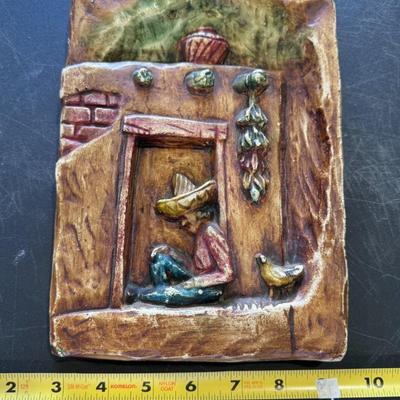
decorative ceramic wall plaque, commonly recognized as a piece of Mexican Talavera pottery. Here's more about it: Style and Origin: This plaque embodies the traditional Talavera style, a renowned form of handcrafted Mexican ceramic art known for its vibrant colors and intricate designs. It originates from Mexico, with Talavera de la Reina in Spain being the root of this style, brought to Mexico after the Spanish conquest. Depiction: The plaque depicts a "siesta man," a common motif in Mexican folk art, often shown resting or sleeping under a sombrero, frequently accompanied by animals like the chicken seen in your image. Material and Craftsmanship: It is made from glazed stoneware, meticulously hand-painted by skilled artisans, which means each piece can have slight variations in color and design, adding to its unique charm. 1124 / 1369 -
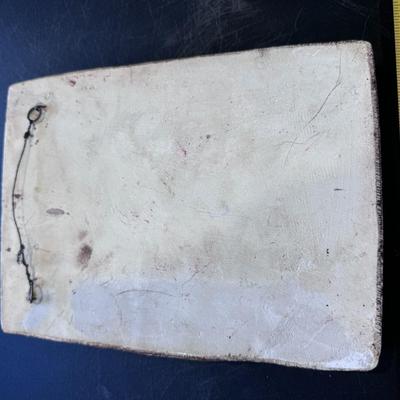
decorative ceramic wall plaque, commonly recognized as a piece of Mexican Talavera pottery. Here's more about it: Style and Origin: This plaque embodies the traditional Talavera style, a renowned form of handcrafted Mexican ceramic art known for its vibrant colors and intricate designs. It originates from Mexico, with Talavera de la Reina in Spain being the root of this style, brought to Mexico after the Spanish conquest. Depiction: The plaque depicts a "siesta man," a common motif in Mexican folk art, often shown resting or sleeping under a sombrero, frequently accompanied by animals like the chicken seen in your image. Material and Craftsmanship: It is made from glazed stoneware, meticulously hand-painted by skilled artisans, which means each piece can have slight variations in color and design, adding to its unique charm. 1125 / 1369 -
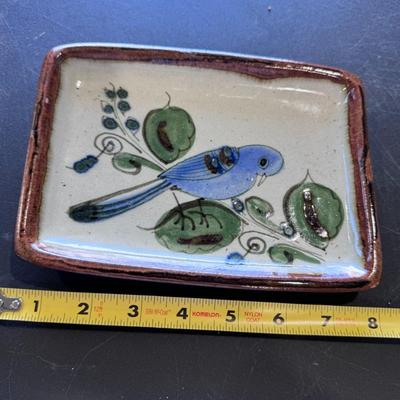
Artist and Origin: This tray is a creation from the studio of Ken Edwards, an American ceramicist who moved to Tonalá, Jalisco, Mexico, in the 1960s and established his studio there. He was instrumental in developing high-fired stoneware techniques in the region. Stoneware and Craftsmanship: Ken Edwards pottery is known for its durable stoneware, which is high-fired and often lead-free, making it food-safe and suitable for microwave, oven, and dishwasher use. Each piece is hand-decorated by skilled artisans, often featuring distinct designs like the bird motif seen on your tray. Signatures and Marks: Authentic Ken Edwards pieces are typically signed with "KE Mexico" and may also include a symbol, like an animal or insect, indicating the specific artisan who painted it. 1126 / 1369 -
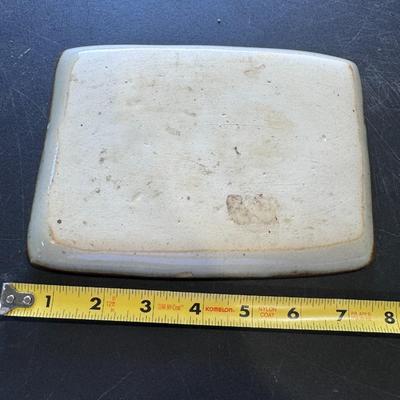
Artist and Origin: This tray is a creation from the studio of Ken Edwards, an American ceramicist who moved to Tonalá, Jalisco, Mexico, in the 1960s and established his studio there. He was instrumental in developing high-fired stoneware techniques in the region. Stoneware and Craftsmanship: Ken Edwards pottery is known for its durable stoneware, which is high-fired and often lead-free, making it food-safe and suitable for microwave, oven, and dishwasher use. Each piece is hand-decorated by skilled artisans, often featuring distinct designs like the bird motif seen on your tray. Signatures and Marks: Authentic Ken Edwards pieces are typically signed with "KE Mexico" and may also include a symbol, like an animal or insect, indicating the specific artisan who painted it. 1127 / 1369 -
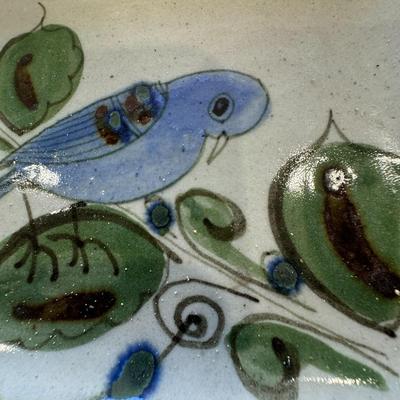
Artist and Origin: This tray is a creation from the studio of Ken Edwards, an American ceramicist who moved to Tonalá, Jalisco, Mexico, in the 1960s and established his studio there. He was instrumental in developing high-fired stoneware techniques in the region. Stoneware and Craftsmanship: Ken Edwards pottery is known for its durable stoneware, which is high-fired and often lead-free, making it food-safe and suitable for microwave, oven, and dishwasher use. Each piece is hand-decorated by skilled artisans, often featuring distinct designs like the bird motif seen on your tray. Signatures and Marks: Authentic Ken Edwards pieces are typically signed with "KE Mexico" and may also include a symbol, like an animal or insect, indicating the specific artisan who painted it. 1128 / 1369 -
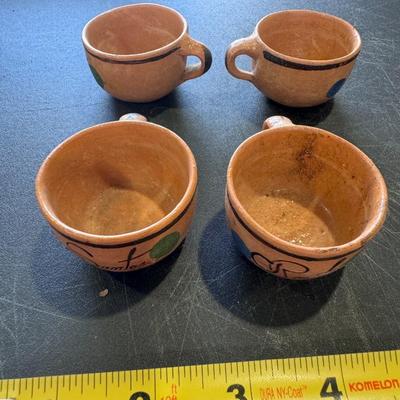
Origin & Craftsmanship: These mugs are handcrafted in Mexico, often associated with regions like Tlaquepaque or Tonala. They are typically made by local artisans using traditional methods and hand-painted with various designs. Material & Features: Constructed from natural clay, these cups are known for their ability to maintain beverage temperatures, keeping drinks cool or warm. Many are finished with a lead-free glaze on the interior for safety and durability, while the exterior often retains a natural, rustic clay texture. Traditional Uses: While suitable for coffee or hot chocolate, these "jarritos" are also traditionally used for serving refreshing beverages like "aguas frescas," tequila-based cocktails, or other traditional Mexican drinks like "champurrado" or "pulque". 1129 / 1369 -
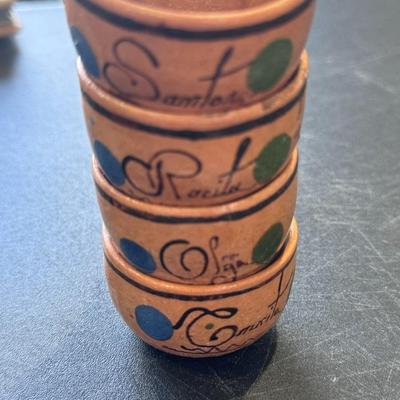
Origin & Craftsmanship: These mugs are handcrafted in Mexico, often associated with regions like Tlaquepaque or Tonala. They are typically made by local artisans using traditional methods and hand-painted with various designs. Material & Features: Constructed from natural clay, these cups are known for their ability to maintain beverage temperatures, keeping drinks cool or warm. Many are finished with a lead-free glaze on the interior for safety and durability, while the exterior often retains a natural, rustic clay texture. Traditional Uses: While suitable for coffee or hot chocolate, these "jarritos" are also traditionally used for serving refreshing beverages like "aguas frescas," tequila-based cocktails, or other traditional Mexican drinks like "champurrado" or "pulque". 1130 / 1369 -
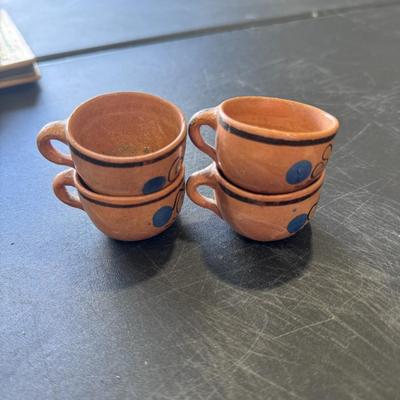
Origin & Craftsmanship: These mugs are handcrafted in Mexico, often associated with regions like Tlaquepaque or Tonala. They are typically made by local artisans using traditional methods and hand-painted with various designs. Material & Features: Constructed from natural clay, these cups are known for their ability to maintain beverage temperatures, keeping drinks cool or warm. Many are finished with a lead-free glaze on the interior for safety and durability, while the exterior often retains a natural, rustic clay texture. Traditional Uses: While suitable for coffee or hot chocolate, these "jarritos" are also traditionally used for serving refreshing beverages like "aguas frescas," tequila-based cocktails, or other traditional Mexican drinks like "champurrado" or "pulque". 1131 / 1369 -
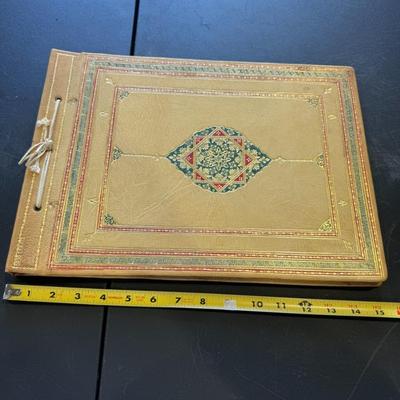
just album- no pics 1132 / 1369 -
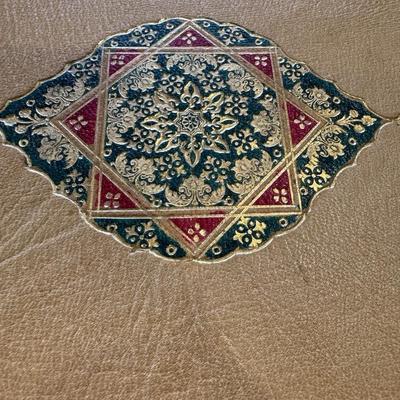
just album- no pics 1133 / 1369 -
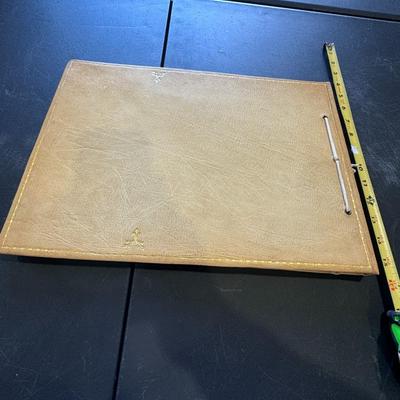
just album- no pics 1134 / 1369 -
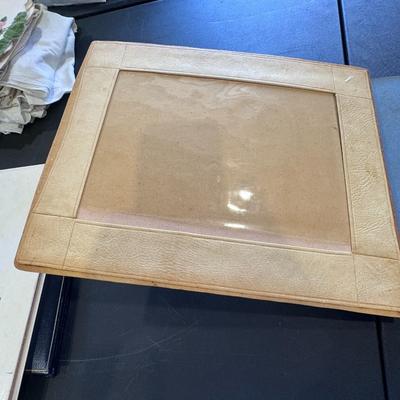
just album- no pics 1135 / 1369 -
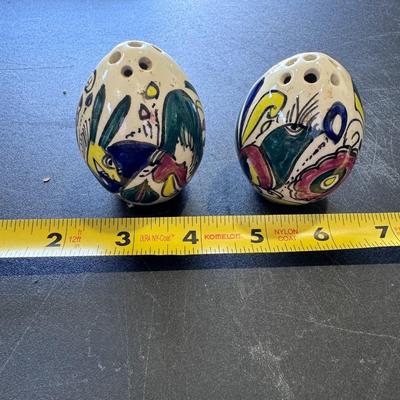
Origin: Possibly from Mexico or Portugal, given the folk art style and similar search results like "Berardos Pottery of Portugal" and "Mexican Pottery Folk Art Owl Figurine". Material & Style: Made of ceramic and feature a vibrant, hand-painted folk art design, often associated with a "boho" or country kitchen aesthetic. Functionality: Designed as salt and pepper shakers, with holes at the top for dispensing and an opening at the bottom for refilling (though stoppers may be missing in vintage sets). 1136 / 1369 -
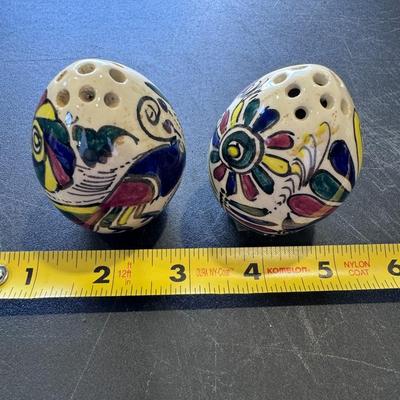
Origin: Possibly from Mexico or Portugal, given the folk art style and similar search results like "Berardos Pottery of Portugal" and "Mexican Pottery Folk Art Owl Figurine". Material & Style: Made of ceramic and feature a vibrant, hand-painted folk art design, often associated with a "boho" or country kitchen aesthetic. Functionality: Designed as salt and pepper shakers, with holes at the top for dispensing and an opening at the bottom for refilling (though stoppers may be missing in vintage sets). 1137 / 1369 -

Ring with a prominent blue stone and a yellow gold-toned band. Based on the provided context and search results, this appears to be a Yellow Gold Ring with a Blue Stone, likely a Topaz or Sapphire. Here's some information about this type of ring: Material: offering durability and a classic look. Gemstone: The blue stone could be various types, including natural gemstones like Blue Topaz (often found in shades like Sky Blue, Swiss Blue, or London Blue), Sapphire, or possibly a simulated or created stone. 1138 / 1369 -
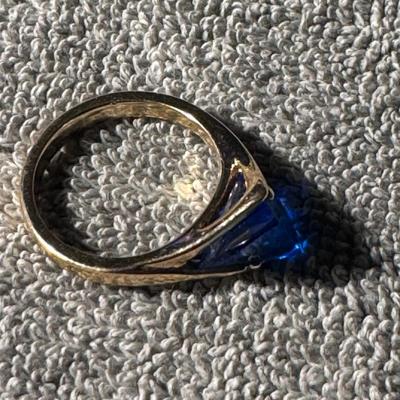
Ring with a prominent blue stone and a yellow gold-toned band. Based on the provided context and search results, this appears to be a Yellow Gold Ring with a Blue Stone, likely a Topaz or Sapphire. Here's some information about this type of ring: Material: offering durability and a classic look. Gemstone: The blue stone could be various types, including natural gemstones like Blue Topaz (often found in shades like Sky Blue, Swiss Blue, or London Blue), Sapphire, or possibly a simulated or created stone. 1139 / 1369 -

Märklin Mini-Club Z Gauge 8611 Shell Tank Car. About the model: It is a Z scale model. It is a 2-axle tank car with a durable plastic body construction and metal trim parts. It measures approximately 1 1/2" long. It features intricate detailing, metal wheels and axles, and fish-hook style couplers. The corporate roadname on the tank car is Deutsche Bahn. The model is associated with the Shell franchise. It's a vintage model. It was manufactured in 1990. It uses an analog control system. 1140 / 1369 -
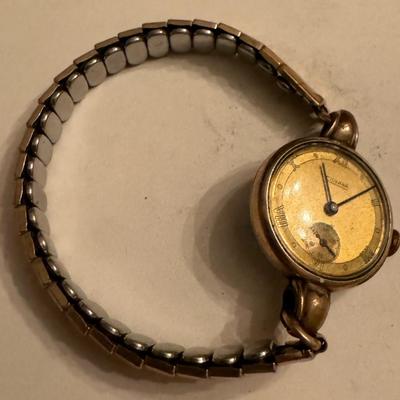
The image shows a vintage wristwatch with the "Silvana" brand name on the dial. Silvana is a Swiss watch brand with a history dating back to 1898 in La Chaux-de-Fonds. Identifying Details: Brand: Silvana Style: Vintage wristwatch Dial: Features a sub-dial at the 9 o'clock position (likely a seconds sub-dial) and Roman numeral hour markers. 1145 / 1369 -
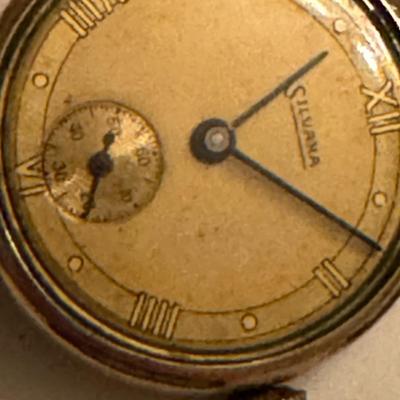
The image shows a vintage wristwatch with the "Silvana" brand name on the dial. Silvana is a Swiss watch brand with a history dating back to 1898 in La Chaux-de-Fonds. Identifying Details: Brand: Silvana Style: Vintage wristwatch Dial: Features a sub-dial at the 9 o'clock position (likely a seconds sub-dial) and Roman numeral hour markers. 1146 / 1369 -
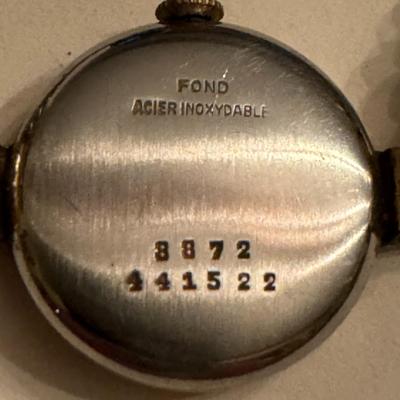
The image shows a vintage wristwatch with the "Silvana" brand name on the dial. Silvana is a Swiss watch brand with a history dating back to 1898 in La Chaux-de-Fonds. Identifying Details: Brand: Silvana Style: Vintage wristwatch Dial: Features a sub-dial at the 9 o'clock position (likely a seconds sub-dial) and Roman numeral hour markers. 1147 / 1369 -
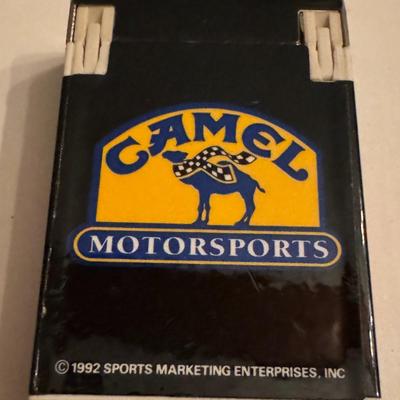
Camel GT Racing Joe GT Racing lighter. This is a collectible item that features Joe Camel in racing attire next to a race car with the text "CAMEL GT" visible. This lighter is part of the larger Camel GT Racing motorsports memorabilia line. The Joe Camel character was prominently featured in Camel cigarette advertising and promotional materials during the 1990s, often associated with a variety of sports and activities, including motorsports. 1148 / 1369 -

Camel GT Racing Joe GT Racing lighter. This is a collectible item that features Joe Camel in racing attire next to a race car with the text "CAMEL GT" visible. This lighter is part of the larger Camel GT Racing motorsports memorabilia line. The Joe Camel character was prominently featured in Camel cigarette advertising and promotional materials during the 1990s, often associated with a variety of sports and activities, including motorsports. 1149 / 1369 -
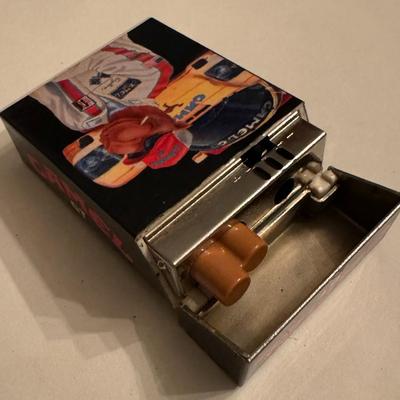
Camel GT Racing Joe GT Racing lighter. This is a collectible item that features Joe Camel in racing attire next to a race car with the text "CAMEL GT" visible. This lighter is part of the larger Camel GT Racing motorsports memorabilia line. The Joe Camel character was prominently featured in Camel cigarette advertising and promotional materials during the 1990s, often associated with a variety of sports and activities, including motorsports. 1150 / 1369 -
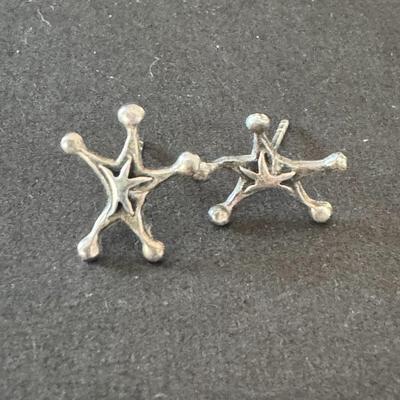
Sterling Silver Whimsical Goodnight Stars Stud Post Earrings. These earrings are characterized by their playful, star-shaped design with an antique finish to enhance the details, giving them a whimsical look as if they came from a children's book. They are designed to be worn as stud earrings and are made of sterling silver. 1151 / 1369 -
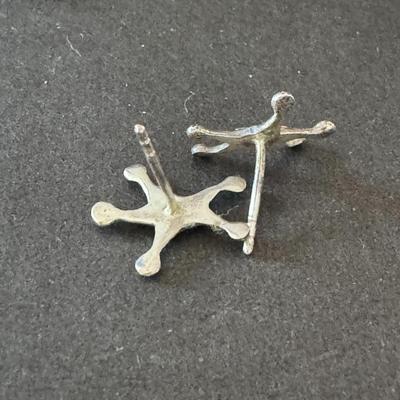
Sterling Silver Whimsical Goodnight Stars Stud Post Earrings. These earrings are characterized by their playful, star-shaped design with an antique finish to enhance the details, giving them a whimsical look as if they came from a children's book. They are designed to be worn as stud earrings and are made of sterling silver. 1152 / 1369 -
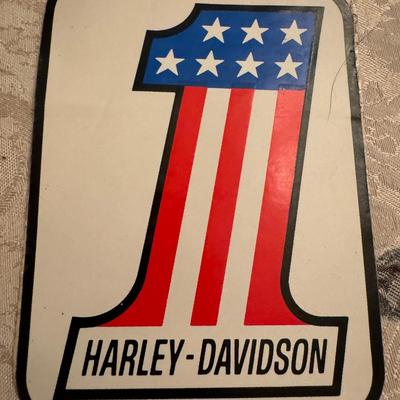
Harley-Davidson #1 logo, a well-known symbol in motorcycle culture. It typically features the number "1" with stars and stripes resembling the American flag. History of the logo: The #1 logo was originally created to celebrate Harley-Davidson racer Mert Lawwill's 1969 AMA Grand National Championship season title. It was later modified to include stars within the logo. The logo became a common symbol for Harley-Davidson in the 1970s and has been revived in recent years. In 1971, Willie G. Davidson, Vice President of Styling for Harley-Davidson, had the logo incorporated into the dashboard of the 1971 FX Super Glide® motorcycle. 1153 / 1369 -
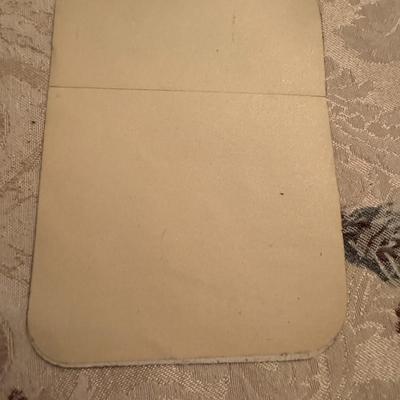
Harley-Davidson #1 logo, a well-known symbol in motorcycle culture. It typically features the number "1" with stars and stripes resembling the American flag. History of the logo: The #1 logo was originally created to celebrate Harley-Davidson racer Mert Lawwill's 1969 AMA Grand National Championship season title. It was later modified to include stars within the logo. The logo became a common symbol for Harley-Davidson in the 1970s and has been revived in recent years. In 1971, Willie G. Davidson, Vice President of Styling for Harley-Davidson, had the logo incorporated into the dashboard of the 1971 FX Super Glide® motorcycle. 1154 / 1369 -
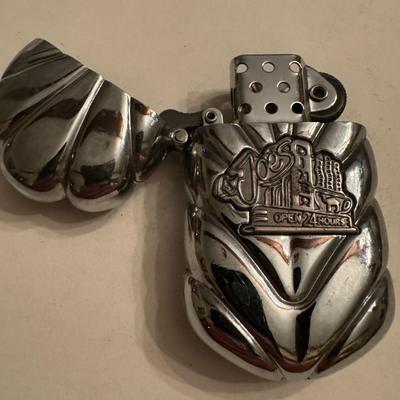
Appears un-used The image shows a vintage Joe Camel "Joe's Diner Open 24 Hours" lighter. Details about the lighter: Design: It features the iconic Joe Camel character and the "Joe's Diner Open 24 Hours" slogan, often with an Art Deco aesthetic. Material: It is typically made of chrome or a silver-tone metal and may have a clamshell-like design. Origin and Era: These lighters were promotional items for Camel cigarettes in the 1980s or 1990s, particularly around 1994. 1155 / 1369 -
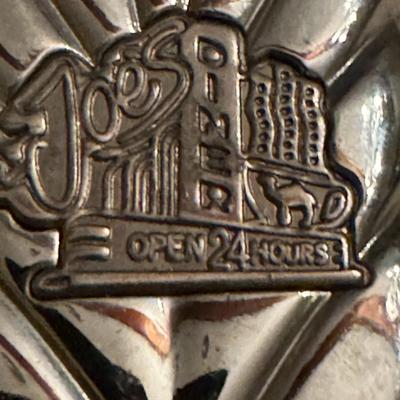
Appears un-used The image shows a vintage Joe Camel "Joe's Diner Open 24 Hours" lighter. Details about the lighter: Design: It features the iconic Joe Camel character and the "Joe's Diner Open 24 Hours" slogan, often with an Art Deco aesthetic. Material: It is typically made of chrome or a silver-tone metal and may have a clamshell-like design. Origin and Era: These lighters were promotional items for Camel cigarettes in the 1980s or 1990s, particularly around 1994. 1156 / 1369 -
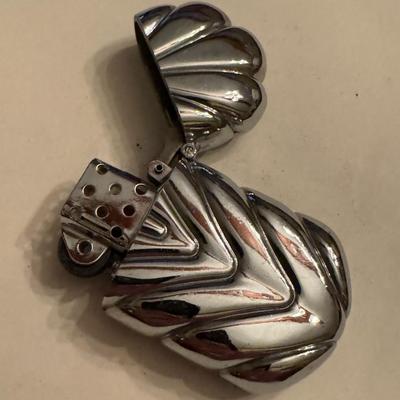
Appears un-used The image shows a vintage Joe Camel "Joe's Diner Open 24 Hours" lighter. Details about the lighter: Design: It features the iconic Joe Camel character and the "Joe's Diner Open 24 Hours" slogan, often with an Art Deco aesthetic. Material: It is typically made of chrome or a silver-tone metal and may have a clamshell-like design. Origin and Era: These lighters were promotional items for Camel cigarettes in the 1980s or 1990s, particularly around 1994. 1157 / 1369 -
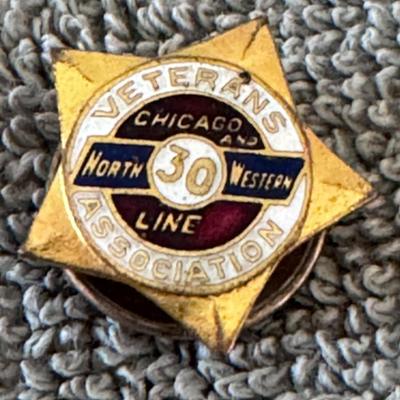
Chicago and Northwestern (C&NW) Line Veterans Association service pin, specifically commemorating 30 years of service. Here is more information about the pin: Purpose: The Chicago and Northwestern Railway awarded these pins to employees who were members of its Veterans Association. They recognized significant milestones of service to the railroad. Design: The pin likely features the Chicago and Northwestern Line name. It probably uses the "ball and bar" logo or a variation of it, which was a well-known symbol of the railroad. The number "30" indicates the years of service being recognized. Historical Significance: The Chicago and Northwestern Railway was a major Class I railroad in the Midwestern United States. It operated for over a century before Union Pacific acquired it. These pins are tangible pieces of its history and reflect the dedication of long-serving employees. 1158 / 1369 -
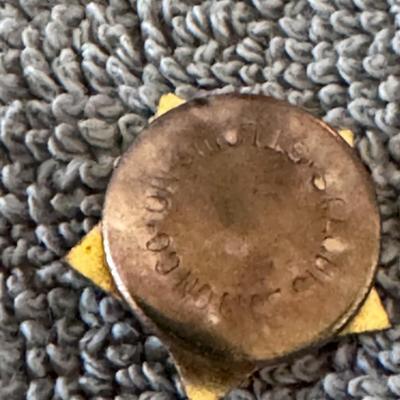
Chicago and Northwestern (C&NW) Line Veterans Association service pin, specifically commemorating 30 years of service. Here is more information about the pin: Purpose: The Chicago and Northwestern Railway awarded these pins to employees who were members of its Veterans Association. They recognized significant milestones of service to the railroad. Design: The pin likely features the Chicago and Northwestern Line name. It probably uses the "ball and bar" logo or a variation of it, which was a well-known symbol of the railroad. The number "30" indicates the years of service being recognized. Historical Significance: The Chicago and Northwestern Railway was a major Class I railroad in the Midwestern United States. It operated for over a century before Union Pacific acquired it. These pins are tangible pieces of its history and reflect the dedication of long-serving employees. 1159 / 1369 -
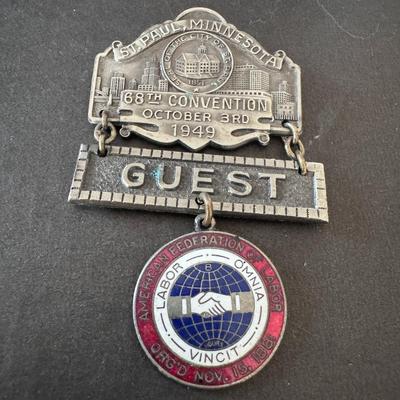
1949 Guest Badge from the 68th Convention of the American Federation of Labor (AFL), held in St. Paul, Minnesota on October 3rd, 1949. Key details about the badge and the event: Organization: The badge represents the American Federation of Labor (AFL), a national federation of labor unions in the United States, founded on November 15, 1881, as indicated by "ORG'D NOV. 15, 1881" on the lower medallion. Convention Details: The badge specifically commemorates the 68th Annual Convention of the AFL, which took place on October 3rd, 1949, in St. Paul, Minnesota, as stated on the upper portion of the badge. Design Elements: The badge features a detailed upper section depicting the St. Paul city skyline, with the text "ST. PAUL, MINNESOTA" and "68TH CONVENTION OCTOBER 3RD 1949." A central bar prominently displays the word "GUEST," indicating its purpose. 1165 / 1369 -
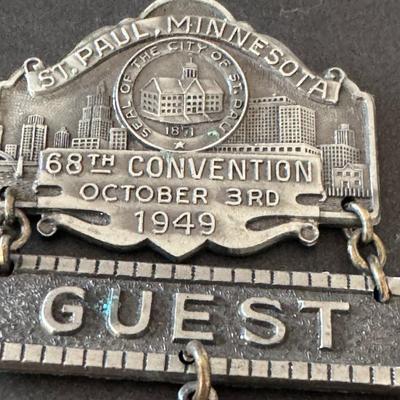
1949 Guest Badge from the 68th Convention of the American Federation of Labor (AFL), held in St. Paul, Minnesota on October 3rd, 1949. Key details about the badge and the event: Organization: The badge represents the American Federation of Labor (AFL), a national federation of labor unions in the United States, founded on November 15, 1881, as indicated by "ORG'D NOV. 15, 1881" on the lower medallion. Convention Details: The badge specifically commemorates the 68th Annual Convention of the AFL, which took place on October 3rd, 1949, in St. Paul, Minnesota, as stated on the upper portion of the badge. Design Elements: The badge features a detailed upper section depicting the St. Paul city skyline, with the text "ST. PAUL, MINNESOTA" and "68TH CONVENTION OCTOBER 3RD 1949." A central bar prominently displays the word "GUEST," indicating its purpose. 1166 / 1369 -
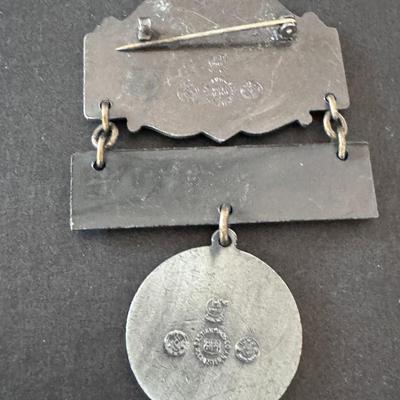
1949 Guest Badge from the 68th Convention of the American Federation of Labor (AFL), held in St. Paul, Minnesota on October 3rd, 1949. Key details about the badge and the event: Organization: The badge represents the American Federation of Labor (AFL), a national federation of labor unions in the United States, founded on November 15, 1881, as indicated by "ORG'D NOV. 15, 1881" on the lower medallion. Convention Details: The badge specifically commemorates the 68th Annual Convention of the AFL, which took place on October 3rd, 1949, in St. Paul, Minnesota, as stated on the upper portion of the badge. Design Elements: The badge features a detailed upper section depicting the St. Paul city skyline, with the text "ST. PAUL, MINNESOTA" and "68TH CONVENTION OCTOBER 3RD 1949." A central bar prominently displays the word "GUEST," indicating its purpose. 1167 / 1369 -
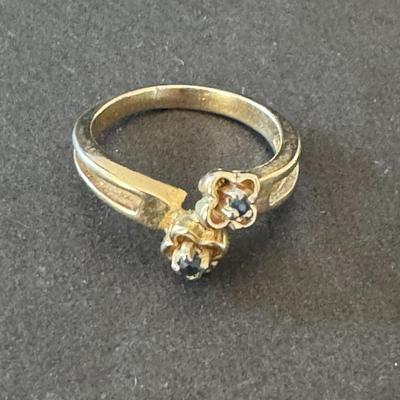
The ring in the image is a two-stone ring, also known as a Toi et Moi ring, which is French for "you and me". This style has two gemstones set side-by-side, symbolizing the union and connection of two individuals. The stones in the ring appear to be blue, possibly sapphires or another blue gemstone, set in a yellow band. Here's more information about this style of ring: Symbolism: Toi et Moi rings are deeply symbolic, representing partnership, love, and the merging of two stories or souls into one. History: The design's popularity is often attributed to Napoleon Bonaparte, who famously gifted one to Josephine de Beauharnais in the late 18th century. Variations: While traditionally featuring two prominent stones, variations can include different gemstone types (like diamonds, sapphires, emeralds, or rubies) and cuts (pear, emerald, radiant, princess, or round), as well as different metal types. 1168 / 1369 -

The ring in the image is a two-stone ring, also known as a Toi et Moi ring, which is French for "you and me". This style has two gemstones set side-by-side, symbolizing the union and connection of two individuals. The stones in the ring appear to be blue, possibly sapphires or another blue gemstone, set in a yellow band. Here's more information about this style of ring: Symbolism: Toi et Moi rings are deeply symbolic, representing partnership, love, and the merging of two stories or souls into one. History: The design's popularity is often attributed to Napoleon Bonaparte, who famously gifted one to Josephine de Beauharnais in the late 18th century. Variations: While traditionally featuring two prominent stones, variations can include different gemstone types (like diamonds, sapphires, emeralds, or rubies) and cuts (pear, emerald, radiant, princess, or round), as well as different metal types. 1169 / 1369 -
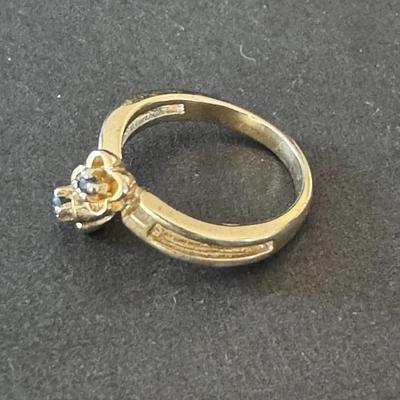
The ring in the image is a two-stone ring, also known as a Toi et Moi ring, which is French for "you and me". This style has two gemstones set side-by-side, symbolizing the union and connection of two individuals. The stones in the ring appear to be blue, possibly sapphires or another blue gemstone, set in a yellow band. Here's more information about this style of ring: Symbolism: Toi et Moi rings are deeply symbolic, representing partnership, love, and the merging of two stories or souls into one. History: The design's popularity is often attributed to Napoleon Bonaparte, who famously gifted one to Josephine de Beauharnais in the late 18th century. Variations: While traditionally featuring two prominent stones, variations can include different gemstone types (like diamonds, sapphires, emeralds, or rubies) and cuts (pear, emerald, radiant, princess, or round), as well as different metal types. 1170 / 1369 -
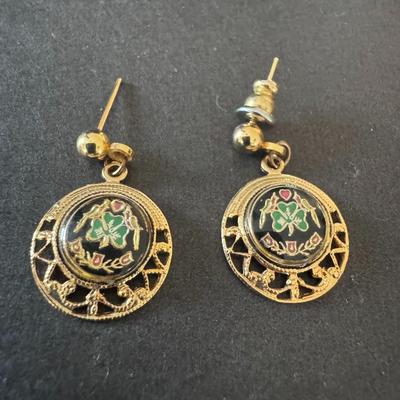
gold-tone drop earrings featuring a black enameled central disc with a green shamrock or three-leaf clover design. The shamrock, a classic Irish symbol, is often associated with St. Patrick and good luck. Here's more information about these types of earrings: Design Details: The earrings have a circular, openwork gold-tone frame surrounding a black enamel disc where the green shamrock motif is prominently displayed. One earring appears to have a standard post-and-butterfly back, while the other might have a different backing mechanism, possibly a screw back or a modified post, as indicated by the visual details. Symbolism: The shamrock (or three-leaf clover) is deeply rooted in Irish culture, famously used by St. Patrick to explain the Holy Trinity. It has also become a widespread symbol of good fortune, hope, and the natural world, particularly when featuring three leaves. 1173 / 1369 -
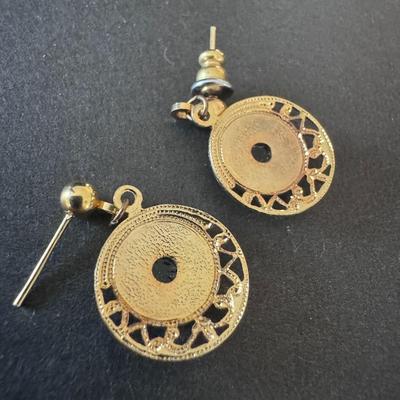
gold-tone drop earrings featuring a black enameled central disc with a green shamrock or three-leaf clover design. The shamrock, a classic Irish symbol, is often associated with St. Patrick and good luck. Here's more information about these types of earrings: Design Details: The earrings have a circular, openwork gold-tone frame surrounding a black enamel disc where the green shamrock motif is prominently displayed. One earring appears to have a standard post-and-butterfly back, while the other might have a different backing mechanism, possibly a screw back or a modified post, as indicated by the visual details. Symbolism: The shamrock (or three-leaf clover) is deeply rooted in Irish culture, famously used by St. Patrick to explain the Holy Trinity. It has also become a widespread symbol of good fortune, hope, and the natural world, particularly when featuring three leaves. 1174 / 1369 -
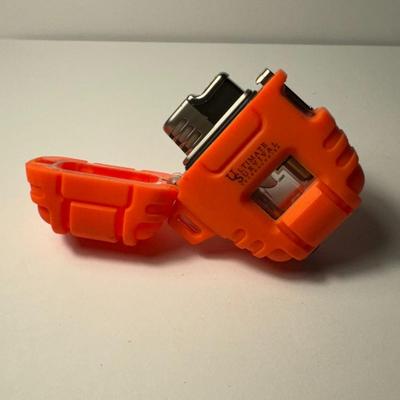
blaze orange Windmill Delta Shockproof Lighter. This model is designed to be stormproof and shockproof, featuring a tough elastomer armor over a polycarbonate casing for incredible impact resistance. It uses a piezo-electric ignition system, eliminating the need for flints or batteries that can fail when wet. This ignition system is rated for over 30,000 ignitions and allows for easy, one-handed operation. The lighter also features a stainless steel wire closure to ensure it remains watertight, even if dropped. O-ring seals help to prevent water intrusion when the cap is closed. The flame is powered by butane gas and produced by a catalyzer coil, which provides a strong, windproof flame capable of withstanding winds of 70-80 miles per hour. It burns with a clean, hot flame at 2,000 degrees Fahrenheit. There is a flame indicator window that glows when the lighter is ignited, and a fuel level indicator allows you to visually check the fuel level. The lighter itself is relatively lightweight at 2 ounces (empty) and measures 2.6" x 2.05" x 0.93". 1175 / 1369 -

blaze orange Windmill Delta Shockproof Lighter. This model is designed to be stormproof and shockproof, featuring a tough elastomer armor over a polycarbonate casing for incredible impact resistance. It uses a piezo-electric ignition system, eliminating the need for flints or batteries that can fail when wet. This ignition system is rated for over 30,000 ignitions and allows for easy, one-handed operation. The lighter also features a stainless steel wire closure to ensure it remains watertight, even if dropped. O-ring seals help to prevent water intrusion when the cap is closed. The flame is powered by butane gas and produced by a catalyzer coil, which provides a strong, windproof flame capable of withstanding winds of 70-80 miles per hour. It burns with a clean, hot flame at 2,000 degrees Fahrenheit. There is a flame indicator window that glows when the lighter is ignited, and a fuel level indicator allows you to visually check the fuel level. The lighter itself is relatively lightweight at 2 ounces (empty) and measures 2.6" x 2.05" x 0.93". 1176 / 1369 -

blaze orange Windmill Delta Shockproof Lighter. This model is designed to be stormproof and shockproof, featuring a tough elastomer armor over a polycarbonate casing for incredible impact resistance. It uses a piezo-electric ignition system, eliminating the need for flints or batteries that can fail when wet. This ignition system is rated for over 30,000 ignitions and allows for easy, one-handed operation. The lighter also features a stainless steel wire closure to ensure it remains watertight, even if dropped. O-ring seals help to prevent water intrusion when the cap is closed. The flame is powered by butane gas and produced by a catalyzer coil, which provides a strong, windproof flame capable of withstanding winds of 70-80 miles per hour. It burns with a clean, hot flame at 2,000 degrees Fahrenheit. There is a flame indicator window that glows when the lighter is ignited, and a fuel level indicator allows you to visually check the fuel level. The lighter itself is relatively lightweight at 2 ounces (empty) and measures 2.6" x 2.05" x 0.93". 1177 / 1369 -
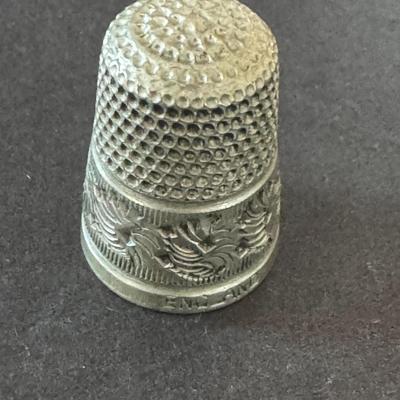
sterling silver thimble, a popular material for both functional and collectible thimbles. To learn more about this specific thimble, you would look for potential markings: Hallmarks or maker's marks: These tiny engravings on the thimble, often found on the rim, side, or inside the dome, can indicate the maker, the metal composition (e.g., "STERLING," "925"), and sometimes the country or city of origin and even the year of manufacture. Size indication: Thimbles are sized, and often the size number is marked, usually on the side or inside the top. 1178 / 1369 -
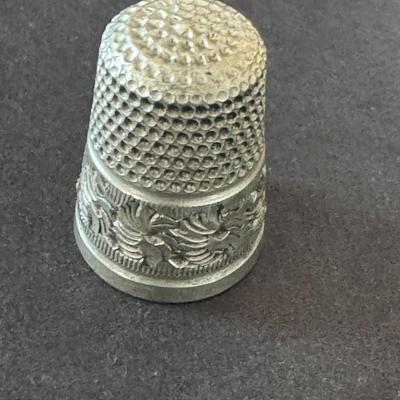
sterling silver thimble, a popular material for both functional and collectible thimbles. To learn more about this specific thimble, you would look for potential markings: Hallmarks or maker's marks: These tiny engravings on the thimble, often found on the rim, side, or inside the dome, can indicate the maker, the metal composition (e.g., "STERLING," "925"), and sometimes the country or city of origin and even the year of manufacture. Size indication: Thimbles are sized, and often the size number is marked, usually on the side or inside the top. 1179 / 1369 -
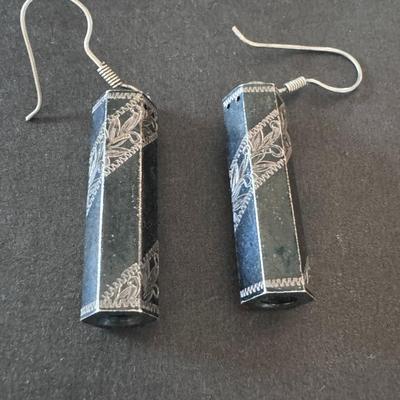
Elegant black rectangular dangle earrings with intricate silver-colored filigree or engraved designs. Here's more information about these types of earrings: Design and Style: They feature a rectangular base, likely made of a dark stone like black onyx or a similar material, adorned with delicate, swirling patterns in a lighter metal, characteristic of filigree work. The design suggests a vintage or artisan aesthetic. Materials: While the exact material of the black component isn't specified, it strongly resembles black onyx, often paired with sterling silver for the filigree elements and ear hooks. 1180 / 1369 -
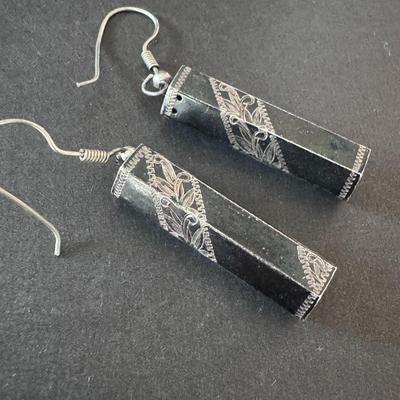
Elegant black rectangular dangle earrings with intricate silver-colored filigree or engraved designs. Here's more information about these types of earrings: Design and Style: They feature a rectangular base, likely made of a dark stone like black onyx or a similar material, adorned with delicate, swirling patterns in a lighter metal, characteristic of filigree work. The design suggests a vintage or artisan aesthetic. Materials: While the exact material of the black component isn't specified, it strongly resembles black onyx, often paired with sterling silver for the filigree elements and ear hooks. 1181 / 1369 -
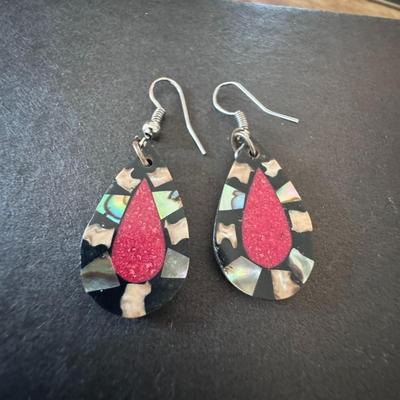
eye-catching teardrop-shaped dangle earrings. Based on similar jewelry designs, these earrings appear to be crafted with a combination of materials: Resin and Mother-of-Pearl Inlay: The black sections and iridescent pieces surrounding the central red element suggest an inlay technique often utilizing resin and fragments of mother-of-pearl shell. Vibrant Red Accent: The central, textured red portion adds a striking contrast to the darker, iridescent outer design, likely made from colored resin or a similar material embedded within the piece. Fish Hook Closures: The earrings are designed with classic fish hook ear wires for comfortable wear. 1182 / 1369 -
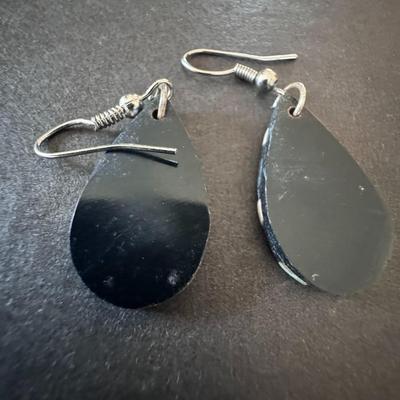
eye-catching teardrop-shaped dangle earrings. Based on similar jewelry designs, these earrings appear to be crafted with a combination of materials: Resin and Mother-of-Pearl Inlay: The black sections and iridescent pieces surrounding the central red element suggest an inlay technique often utilizing resin and fragments of mother-of-pearl shell. Vibrant Red Accent: The central, textured red portion adds a striking contrast to the darker, iridescent outer design, likely made from colored resin or a similar material embedded within the piece. Fish Hook Closures: The earrings are designed with classic fish hook ear wires for comfortable wear. 1183 / 1369 -
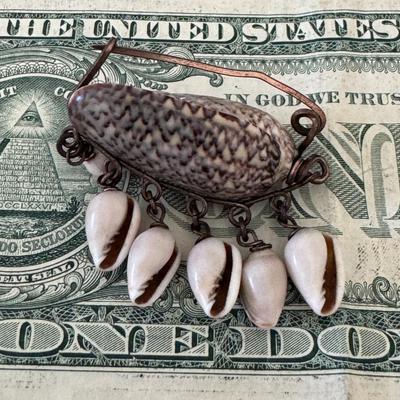
shell jewelry, likely a pendant featuring several shells, including a prominent larger shell and a cluster of smaller, distinctively shaped shells, possibly cowries, all adorned with what appears to be a metal or wire wrapping. This type of jewelry often holds cultural and historical significance in various communities worldwide. Here's more about the shells and their context: Cowrie Shells: The smaller shells clustered together strongly resemble cowrie shells (e.g., Monetaria moneta), which have a long history of use as currency in parts of Africa and Asia, and are still valued for their beauty and symbolic meaning in many cultures. They are often associated with wealth, fertility, protection, and connection to the ocean. 1184 / 1369 -
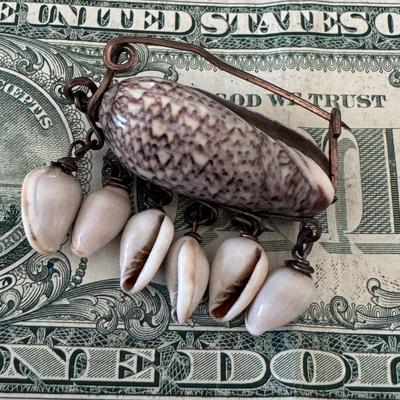
shell jewelry, likely a pendant featuring several shells, including a prominent larger shell and a cluster of smaller, distinctively shaped shells, possibly cowries, all adorned with what appears to be a metal or wire wrapping. This type of jewelry often holds cultural and historical significance in various communities worldwide. Here's more about the shells and their context: Cowrie Shells: The smaller shells clustered together strongly resemble cowrie shells (e.g., Monetaria moneta), which have a long history of use as currency in parts of Africa and Asia, and are still valued for their beauty and symbolic meaning in many cultures. They are often associated with wealth, fertility, protection, and connection to the ocean. 1185 / 1369 -
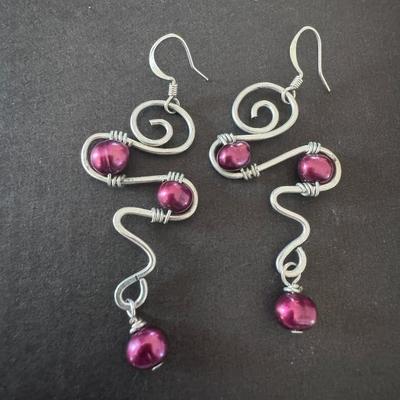
Dark Pink Glass Pearl Twisted Drop Earrings, characterized by their handmade, wire-wrapped design. Key features of these earrings: Materials: They primarily consist of dark pink or purple glass pearls and a silver-toned metal wire, likely silver-plated or sterling silver, used for the twisted or swirled design and the ear hooks. Design: The earrings feature a distinctive wire-wrapped or twisted metalwork that elegantly holds the glass pearls, creating a unique drop or dangle style. Style: The intricate wire design and the rich color of the pearls give them a handcrafted and potentially bohemian or vintage-inspired aesthetic. Craftsmanship: Similar earrings are often handmade, showcasing individual artistry in wire manipulation and bead placement. 1191 / 1369 -
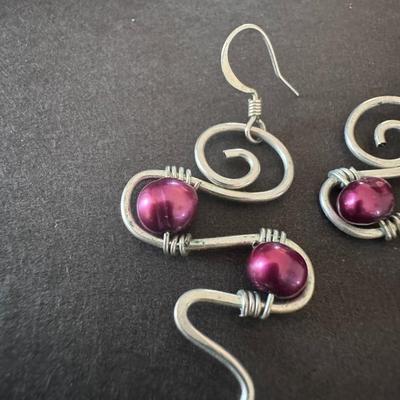
Dark Pink Glass Pearl Twisted Drop Earrings, characterized by their handmade, wire-wrapped design. Key features of these earrings: Materials: They primarily consist of dark pink or purple glass pearls and a silver-toned metal wire, likely silver-plated or sterling silver, used for the twisted or swirled design and the ear hooks. Design: The earrings feature a distinctive wire-wrapped or twisted metalwork that elegantly holds the glass pearls, creating a unique drop or dangle style. Style: The intricate wire design and the rich color of the pearls give them a handcrafted and potentially bohemian or vintage-inspired aesthetic. Craftsmanship: Similar earrings are often handmade, showcasing individual artistry in wire manipulation and bead placement. 1192 / 1369 -
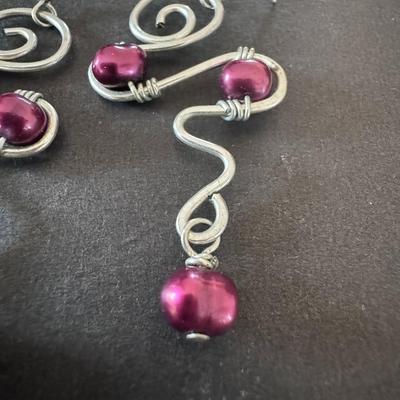
Dark Pink Glass Pearl Twisted Drop Earrings, characterized by their handmade, wire-wrapped design. Key features of these earrings: Materials: They primarily consist of dark pink or purple glass pearls and a silver-toned metal wire, likely silver-plated or sterling silver, used for the twisted or swirled design and the ear hooks. Design: The earrings feature a distinctive wire-wrapped or twisted metalwork that elegantly holds the glass pearls, creating a unique drop or dangle style. Style: The intricate wire design and the rich color of the pearls give them a handcrafted and potentially bohemian or vintage-inspired aesthetic. Craftsmanship: Similar earrings are often handmade, showcasing individual artistry in wire manipulation and bead placement. 1193 / 1369 -
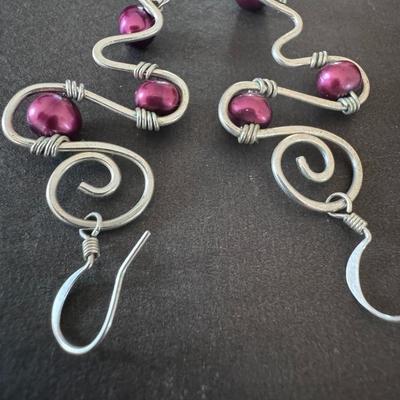
Dark Pink Glass Pearl Twisted Drop Earrings, characterized by their handmade, wire-wrapped design. Key features of these earrings: Materials: They primarily consist of dark pink or purple glass pearls and a silver-toned metal wire, likely silver-plated or sterling silver, used for the twisted or swirled design and the ear hooks. Design: The earrings feature a distinctive wire-wrapped or twisted metalwork that elegantly holds the glass pearls, creating a unique drop or dangle style. Style: The intricate wire design and the rich color of the pearls give them a handcrafted and potentially bohemian or vintage-inspired aesthetic. Craftsmanship: Similar earrings are often handmade, showcasing individual artistry in wire manipulation and bead placement. 1194 / 1369 -
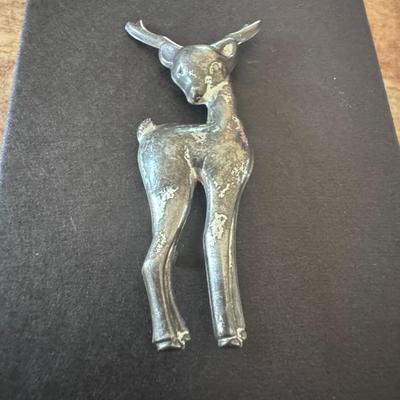
Vintage Sterling Silver Deer Brooch. Here's what is known about this type of item: Material: These brooches are typically made of sterling silver, often indicated by "925" or "Sterling" marks on the back, though some might be unmarked but test as such. Some variations exist in .900 silver, particularly from Mexico. Design & Style: They commonly feature a standing or leaping deer (or reindeer/fawn) design, sometimes with intricate details like etched fur, stylized antlers, and occasionally gemstone or rhinestone eyes. Era & Origin: Many similar pieces are vintage, dating back to the mid-20th century, with some influenced by or attributed to notable designers like Georg Jensen and Arno Malinowski. Mexican silver pieces from the 1940s are also found. Use: As a brooch or pin, it's designed to be worn as an accessory on clothing, such as a coat, dress, or hat, and can also be used as a lapel or tie pin. Some designs include a bail for use as a pendant as well. 1195 / 1369 -
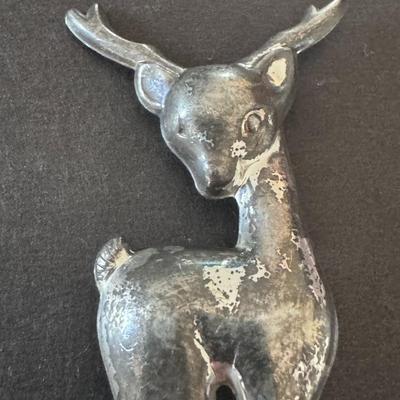
Vintage Sterling Silver Deer Brooch. Here's what is known about this type of item: Material: These brooches are typically made of sterling silver, often indicated by "925" or "Sterling" marks on the back, though some might be unmarked but test as such. Some variations exist in .900 silver, particularly from Mexico. Design & Style: They commonly feature a standing or leaping deer (or reindeer/fawn) design, sometimes with intricate details like etched fur, stylized antlers, and occasionally gemstone or rhinestone eyes. Era & Origin: Many similar pieces are vintage, dating back to the mid-20th century, with some influenced by or attributed to notable designers like Georg Jensen and Arno Malinowski. Mexican silver pieces from the 1940s are also found. Use: As a brooch or pin, it's designed to be worn as an accessory on clothing, such as a coat, dress, or hat, and can also be used as a lapel or tie pin. Some designs include a bail for use as a pendant as well. 1196 / 1369 -
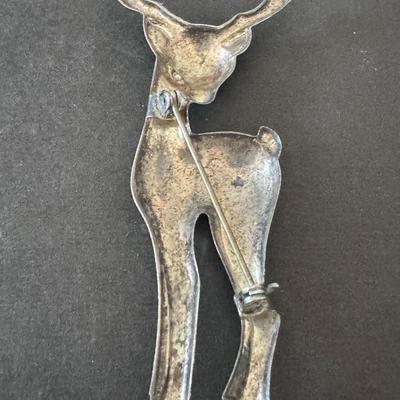
Vintage Sterling Silver Deer Brooch. Here's what is known about this type of item: Material: These brooches are typically made of sterling silver, often indicated by "925" or "Sterling" marks on the back, though some might be unmarked but test as such. Some variations exist in .900 silver, particularly from Mexico. Design & Style: They commonly feature a standing or leaping deer (or reindeer/fawn) design, sometimes with intricate details like etched fur, stylized antlers, and occasionally gemstone or rhinestone eyes. Era & Origin: Many similar pieces are vintage, dating back to the mid-20th century, with some influenced by or attributed to notable designers like Georg Jensen and Arno Malinowski. Mexican silver pieces from the 1940s are also found. Use: As a brooch or pin, it's designed to be worn as an accessory on clothing, such as a coat, dress, or hat, and can also be used as a lapel or tie pin. Some designs include a bail for use as a pendant as well. 1197 / 1369 -
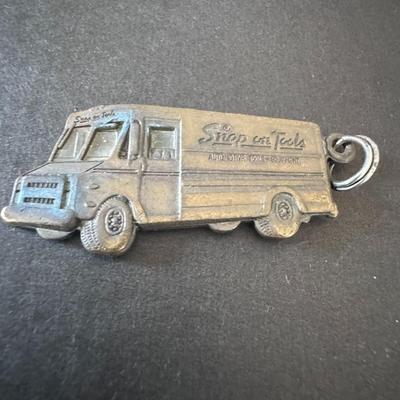
Snap-on Tools truck-shaped keychain, likely made of solid brass. Here's more information about this collectible: Design: It features a detailed rendering of a Snap-on "Super Service" truck, reflecting the company's historical mobile tool distribution model. Material and Condition: These keychains are commonly found in solid brass and often show a vintage patina due to age and use, as seen in the provided image. Collectibility: This type of keychain is a popular collectible among Snap-on enthusiasts, tool collectors, and those interested in vintage advertising memorabilia. Historical Significance: It represents a piece of Snap-on Tools' history and their long-standing presence in the automotive and tools industry. 1198 / 1369 -
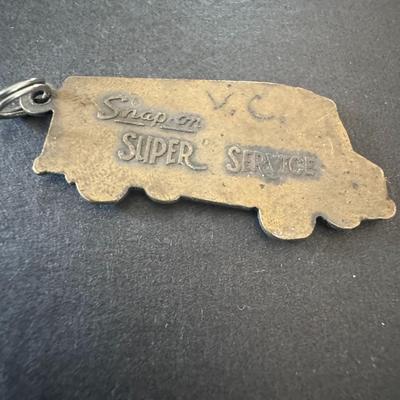
Snap-on Tools truck-shaped keychain, likely made of solid brass. Here's more information about this collectible: Design: It features a detailed rendering of a Snap-on "Super Service" truck, reflecting the company's historical mobile tool distribution model. Material and Condition: These keychains are commonly found in solid brass and often show a vintage patina due to age and use, as seen in the provided image. Collectibility: This type of keychain is a popular collectible among Snap-on enthusiasts, tool collectors, and those interested in vintage advertising memorabilia. Historical Significance: It represents a piece of Snap-on Tools' history and their long-standing presence in the automotive and tools industry. 1199 / 1369 -
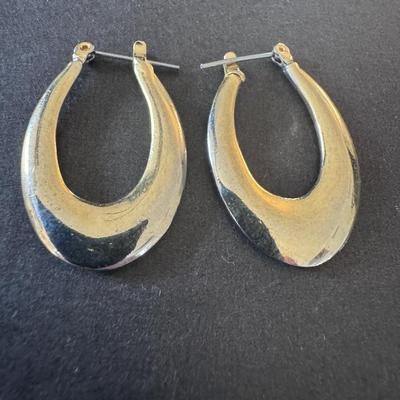
vintage-style, elongated, or oval hoop earrings. While the image displays them in a gold tone, similar styles are also available in sterling silver, often marked with "925" on the ear post to indicate the silver content. These types of earrings are characterized by their distinct shape, offering a sophisticated and slightly more formal alternative to classic round hoops. They are a popular choice for both everyday wear and special occasions due to their timeless appeal and ability to complement various outfits and hairstyles. Many elongated hoop earrings are designed to be lightweight and comfortable for extended wear. 1200 / 1369
Photos 1101 - 1200 of 1369
Per page:
